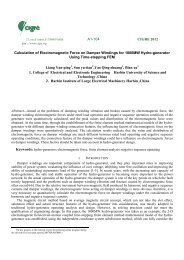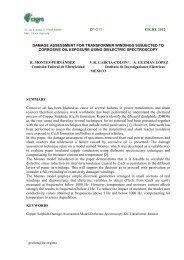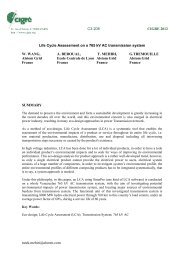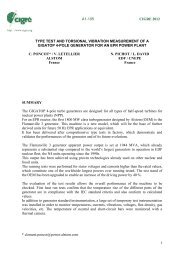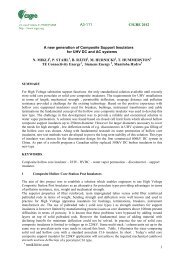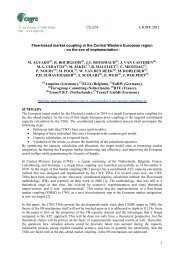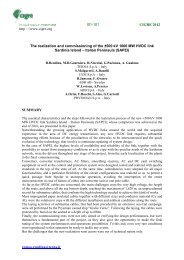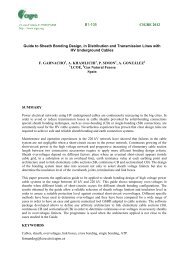0 Planning future transmission grid expansion investments ... - Cigre
0 Planning future transmission grid expansion investments ... - Cigre
0 Planning future transmission grid expansion investments ... - Cigre
Create successful ePaper yourself
Turn your PDF publications into a flip-book with our unique Google optimized e-Paper software.
21, rue d’Artois, F-75008 PARIS C1-201 CIGRE 2012<br />
http://www.cigre.org<br />
<strong>Planning</strong> <strong>future</strong> <strong>transmission</strong> <strong>grid</strong> <strong>expansion</strong> <strong>investments</strong> for a sustainable<br />
pan-European energy system: the REALISEGRID approach<br />
G. Migliavacca 1 , A. L’Abbate, I. Losa, R. Calisti (RSE 2 SpA, Italy)<br />
K. Jansen (TenneT, The Netherlands)<br />
K. Reich, O. Wadosch, F. Leuthold, G. Layr (Austrian Power Grid, Austria)<br />
O. Azadegan, R. Hager, Ch. Todem (RIECADO GmbH, Austria)<br />
H. Weigt (University of Basel, Switzerland)<br />
E.M. Carlini, C. Vergine, A. Sallati (TERNA, Italy)<br />
P. Adam, G. de-Saint-Martin, X. Gallet, J.-Y. Leost (RTE International, France)<br />
SUMMARY<br />
The European <strong>transmission</strong> <strong>grid</strong> plays a critical role towards the achievement of the energy and<br />
climate change policy targets enforced by the European Commission for 2020 and beyond:<br />
environmental sustainability and integration of Renewable Energy Sources (RES), security of energy<br />
supply and system reliability, competitiveness and energy market liberalisation.<br />
To address those challenges, a progressive system re-engineering introducing new driving criteria for<br />
<strong>transmission</strong> network <strong>expansion</strong> is more and more necessary throughout the continent. This has been<br />
also stressed by different recent documents and proposals issued by the European Commission.<br />
The European research project REALISEGRID (September 2008 – May 2011) has investigated the<br />
present <strong>transmission</strong> planning practices and set up a new integrated <strong>transmission</strong> planning framework<br />
able to cope with the challenges deriving by the increasing role of RES and by the decreasing level of<br />
information a TSO (Transmission System Operator) has in a liberalized market with respect to the old<br />
vertically integrated situation.<br />
Aim of this paper is to present two methodologies of such a framework, highlighting the main features<br />
and showing in particular the results of their application to real scale cases referred to the European<br />
<strong>transmission</strong> network.<br />
KEYWORDS<br />
Analysis of investment, competitiveness, cost-benefit analysis, environmental sustainability, RES<br />
integration, security of energy supply, <strong>transmission</strong> planning.<br />
1 Gianluigi.Migliavacca@rse-web.it<br />
2 RSE (Ricerca sul Sistema Energetico) is the new denomination of former ERSE/CESI RICERCA.<br />
The research leading to these results has received funding from the European Community’s Seventh Framework<br />
Programme (FP7/2007-2013) under grant agreement n° 219123 (REALISEGRID project).<br />
0
1. INTRODUCTION<br />
The European electricity <strong>transmission</strong> network plays a critical role towards the achievement of the<br />
energy and climate change policy targets set by the European Commission (EC) for 2020 and beyond:<br />
an effective <strong>grid</strong> integration of a steadily increasing amount of Renewable Energy Sources (RES)<br />
represents a crucial priority, while keeping the system acceptably reliable and progressively removing<br />
all obstacles to the <strong>future</strong> creation of a unified European energy market. To address those challenges, a<br />
gradual system re-engineering is more and more necessary throughout the continent: this will require<br />
the introduction of new criteria for <strong>transmission</strong> network <strong>expansion</strong> planning.<br />
It is important to highlight that, in general, <strong>transmission</strong> planning is a very complex process, which is<br />
made even more complicated by recent trends and challenges. Nowadays, in a liberalized<br />
environment, the vertically unbundled Transmission System Operators (TSOs), responsible for the<br />
sole <strong>transmission</strong> system, have to plan the <strong>expansion</strong> of their network by minimising <strong>transmission</strong><br />
costs (investment and operation) and pursuing social welfare maximization, when requested by<br />
specific regulation, while overcoming bottlenecks and meeting static and dynamic technical<br />
constraints to ensure a secure and economically efficient operation [1].<br />
The basic tasks of <strong>transmission</strong> <strong>grid</strong> planners can be summarized with the following steps [10][13]:<br />
check whether acceptable technical limits might be exceeded on the existing <strong>transmission</strong> network<br />
on the basis of scenarios forecasting <strong>future</strong> power and energy flows, in standard as well as in<br />
contingency conditions (security analysis);<br />
devise, in presence of criticalities, a set of possible <strong>transmission</strong> reinforcements/strategies that<br />
<br />
could overcome the constraints (candidates selection);<br />
perform a cost-benefit analysis among the candidates so as to rank them by priority order taking<br />
into account both costs and benefits provided to the system.<br />
Up to now, the TSOs have mainly kept a national scope in planning <strong>grid</strong> extension. However, the<br />
central role played by the <strong>transmission</strong> infrastructures within the European energy policy calls more<br />
and more for a truly pan-European approach to the planning of new assets, especially those having a<br />
significant cross-border impact. This has been particularly highlighted by recent documents of the EC,<br />
like the so-called Energy Infrastructure Package (Nov. 2010) [7] and the proposal for a new policy<br />
regulation on Trans-European Energy Network (TEN-E) infrastructures [14]. Such an approach entails<br />
harmonizing the different national regulations, fostering the achievement of a coherent policy<br />
promoting the most urgent reinforcements and the most techno-economical solutions, overcoming<br />
possible local opposition by means of transparent information to the public able to provide clear<br />
figures of costs and benefits.<br />
Transmission planning is the central subject investigated by the European research project named<br />
REALISEGRID (http://realise<strong>grid</strong>.rse-web.it) [13], led by RSE, to which twenty European partners,<br />
among which four TSOs, have provided substantial contributions.<br />
Within the REALISEGRID <strong>transmission</strong> planning framework, two different methodologies have<br />
investigated how the planning practice could be modified in order to face the challenges described<br />
above: one oriented to the <strong>investments</strong> analysis by selection of the candidates for network <strong>expansion</strong><br />
and one aimed at performing a multi-criteria cost-benefit analysis able to establish a priority order<br />
among <strong>investments</strong> of European interest.<br />
Concerning <strong>investments</strong> analysis for candidates’ selection, three approaches can be combined<br />
considering various techno-economic and financial aspects related to <strong>transmission</strong> network<br />
<strong>expansion</strong>. A first engineering focused method emphasizes the aspects of reliability and security<br />
of supply (security induced approach). Another approach is based on nodal pricing and is able to<br />
perform network calculations minimizing dispatching costs as it is typical for optimisation studies<br />
(welfare induced approach). A third method also considers the costs deriving from market clearing<br />
in a competitive environment (auction based approach). The innovative idea proposed by<br />
REALISEGRID is to present an integrated methodology suitably encompassing all three above<br />
aspects.<br />
Concerning cost-benefit analysis, the purpose of REALISEGRID is to develop a system-wide<br />
multi-criteria method for project evaluation able to take into account a broad amount of <strong>grid</strong><br />
1
<strong>expansion</strong> benefits, like increased social welfare, losses reduction, more effective dispatch of RES<br />
generation, reduction of CO 2 emission, increased system reliability, etc. This approach aims at<br />
establishing a methodological blueprint for prioritizing new <strong>investments</strong> in a pan-European<br />
framework. This methodology is applied to a realistic case, namely the <strong>transmission</strong> projects<br />
bundle belonging to the TEN-E priority axis EL2 related to the borders of Italy with France,<br />
Austria, Slovenia and Switzerland [8]. This region is one of the most interesting ones to assess the<br />
impact and the benefits of <strong>future</strong> cross-border <strong>transmission</strong> projects.<br />
The paper focuses on the two proposed methodologies and their respective applications. The analyzed<br />
test bed results provide a picture of how these approaches can be applied to realistic trans-national<br />
cases and what types of answers they can provide for the European system.<br />
In this paper, Section 2 presents the new methodology for <strong>investments</strong> analysis towards candidates’<br />
selection. The traditional approach to remove network bottlenecks based on security analysis is<br />
complemented and completed with a technical-economical analysis considering costs and prices in<br />
presence of a liberalized market. An application is provided regarding the <strong>transmission</strong> backbones<br />
around Austria. In Section 3, the new comprehensive multi-criteria cost-benefit analysis, aimed at<br />
ranking alternative reinforcement candidates, is applied by a thorough evaluation of the technical and<br />
economical elements associated to the <strong>investments</strong>. Then, an application to the above quoted EL2<br />
priority axis is outlined, assessing <strong>future</strong> <strong>investments</strong> on the North-Eastern borders of Italy.<br />
2. A NEW METHODOLOGY FOR INVESTMENTS ANALYSIS<br />
The creation of an integrated electricity market requires disposing of an adequate <strong>transmission</strong><br />
capacity. To this aim, a fast <strong>expansion</strong> of the European <strong>transmission</strong> backbones is urgently needed [2].<br />
The right <strong>transmission</strong> capacity <strong>expansion</strong> projects have to be identified which satisfy security of<br />
supply and maximize the social welfare, while considering market operations constraints. All these<br />
aspects are reflected in an integrated market approach [3][4]. Figure 1 provides an overview of this<br />
methodology, in which the limitations of individual approaches focusing on single objectives are<br />
overcome by the combination of the different approaches.<br />
Figure 1: Overview of the methodology for an integrated market approach<br />
Data preparation and assumptions<br />
The dataset considered as starting input for the simulations is based on the REALISEGRID<br />
MARKAL-TIMES long term scenarios for the European energy market [6]. The scenarios results<br />
provide demand, generation capacities and price forecasts up to 2030: here the investigated time<br />
horizons refer to the target years 2020 and 2030. As the long term dataset is aggregated at country<br />
2
level it needs to be partitioned and calibrated to the network nodes in order to allow for a power flow<br />
simulation. Conventional generation is clustered in plant types; marginal costs are derived via fuel and<br />
emission costs and distributed considering both the exploitation of areas already allocated to<br />
generation (Brown Fields) and new sites (Green Fields), whereas RES generation is distributed<br />
according to geographical availability. Demand is distributed locationally based on regional GDP 3 .<br />
Furthermore, twelve weighted demand periods with four seasons and three load levels are taken under<br />
consideration for each analysed year.<br />
Among the long term scenarios elaborated in REALISEGRID, only two representative extreme cases<br />
were chosen: one representing a conservative policy with low emission targets (pessimistic case) and<br />
one with ambitious emission targets (optimistic case). The results obtained implementing the two<br />
scenarios highlight two different kinds of investment policies.<br />
The pessimistic case is characterized by late binding emission targets which reduces the requirements<br />
for an ambitious RES increase in 2020 and lead to an emission allowance price of 0 €/t in 2020. The<br />
price level in Europe is characterized by relatively low electricity prices in most of the considered<br />
countries, largely set by coal units. In 2030 the emission targets become binding leading to an<br />
emission allowance price of 110 €/t. This also leads to a shift in the generation park from coal to gas<br />
and a large increase of RES.<br />
In opposition to the pessimistic case, in the optimistic setting emission targets are binding early on<br />
with an emission allowance price of 160 €/t in 2020 which leads to a diverging generation<br />
development and a much earlier large scale RES deployment. The high allowance price also leads to a<br />
high price levels. In periods where renewable, nuclear and CHP 4 generation are sufficient to cover<br />
demand the price level is significantly lower.<br />
Security of supply induced approach<br />
This method is currently implemented by the TSOs to reinforce the <strong>grid</strong>. New <strong>transmission</strong><br />
infrastructures are generally being built in areas where the (n-1) security criterion threshold is narrow<br />
and therefore urgent reinforcements are needed. This approach may naturally lead to different<br />
necessary <strong>investments</strong> when aiming to ensure the reliability of the <strong>grid</strong>, the security of supply, the<br />
integration of RES and economic efficiency. The technical approach focuses on the feasibility of<br />
certain extension opportunities including technology choice (e.g. cable vs. overhead line) and<br />
technical constraints resulting from security of supply (e.g. reliability).<br />
The 2018 <strong>grid</strong> model developed by ENTSO-E (European Network of Transmission System Operators<br />
for Electricity) for the continental European system, extended by including the projects of ENTSO-E<br />
TYNDP (Ten-Year Network Development Plan) [9], is used as network topology reference for the<br />
study: the power system simulation is carried out by the tool Integral. The repartition of generation<br />
and load for each node is adapted towards a precise power flow simulation. A full load flow<br />
calculation (by the tool TNA 5 ) is carried out which yields for all network elements the available<br />
maximum flows (AMF vector) as well as the PTDF (Power Transfer Distribution Factor) matrix. This<br />
matrix represents the physical flows induced by any energy transport from a particular source market<br />
area to a particular sink market area of the region (also referred to as commercial exchange). In case a<br />
violation occurs, two <strong>grid</strong> reinforcement projects are defined in the model in order to resolve the<br />
selected bottlenecks.<br />
Two bundles of projects have been selected and scrutinised (see Figure 2 and Figure 3). Projects of<br />
category 1 (BAU – business as usual) include mainly 380 kV AC 6 overhead lines (OHLs), the upgrade<br />
with high temperature conductors and double/single circuit loop-in, whereas projects of category 2<br />
(Alternative) are generally more complex and make use of different technologies. They include mainly<br />
3 GDP: Gross Domestic Product<br />
4 CHP: Combined Heat and Power<br />
5 The Transmission Network Analyzer (TNA) is a software tool designed to validate and merge the <strong>transmission</strong><br />
network models, as well as to calculate static load flow, related contingency and sensitivity analyses.<br />
Furthermore a technical parameters calculation is performed according to the flow-based coordinated auctions<br />
principles in the regions of South-East Europe (SEE) and Central-East Europe (CEE) (see<br />
http://www.centralao.com/index.phpoption=com_content&view=article&id=111:usefuldocuments&catid=60:documents&Itemid=136<br />
)<br />
6 AC: Alternating Current; DC: Direct Current<br />
3
DC <strong>transmission</strong> assets (OHL or sea cable) and are an alternative to the classic <strong>grid</strong> <strong>expansion</strong><br />
technologies. Projects of category 1 as well as projects of category 2 of a scenario case (optimistic<br />
“opt” and pessimistic “pes”) are each bundled within a project package. The resulting four project<br />
packages will be evaluated according to their influence on social welfare. Furthermore, six PTDF<br />
matrices and AMF vectors are generated by the TNA tool. These AMF vectors and PTDF matrices are<br />
needed for the investment assessment.<br />
As an overview the <strong>grid</strong> reinforcement projects that would solve (n-1) violations in their respective<br />
areas are listed in Table 1.<br />
Project packages<br />
Project packages<br />
2030_opt project package 1<br />
2030_opt project package 2<br />
2030_pes project package 1<br />
2030_pes project package 2<br />
Figure 4: Project packages<br />
2030_opt project package 1<br />
2030_opt project package 2<br />
2030_pes project package 1<br />
2030_pes project package 2<br />
Figure 5: Project packages<br />
Projects of category 1<br />
Projects of category 2<br />
380 kV AC line Cirkovce-Okroglo (Slovenia)<br />
DC line Obersielach (Austria)–Okroglo (Slovenia)<br />
380 kV AC lines Cordignano–Dugale (Italy) and<br />
Dugale–Ostiglia (Italy)<br />
380 kV AC line Dugale–Ostiglia (Italy) and DC<br />
cable (Italy-Croatia)<br />
high temperature conductors at 220 kV on the<br />
Swiss-Italian border<br />
high temperature conductors at 220 kV on the<br />
Swiss-Italian border<br />
DC line between Switzerland and Italy<br />
DC line between Switzerland and Italy<br />
double-circuit loop-in (Blockland in Germany)<br />
high temperature wire Sottrum–Conneforde<br />
(Germany)<br />
Table 1: Overview of possible projects to solve (n-1) violations in the respective areas<br />
The presented results are very sensitive to the chosen energy scenario and to the spatial distribution of<br />
<strong>future</strong> supply and demand. This dataset has to be assumed only as a possible example of application<br />
for the methodology and is not to be intended as a contribution on <strong>future</strong> <strong>expansion</strong> decisions.<br />
However, the methodology developed and presented here is valuable for supporting TSOs in their <strong>grid</strong><br />
investment selection.<br />
Welfare induced approach<br />
This market-based method identifies investment projects dependent on the development of the<br />
electricity price. This in return is dependent on the increase of supply and demand as well as<br />
<strong>transmission</strong> line projects which increase the overall capacity and volumes of traded electricity. To<br />
derive a welfare optimal network extension the welfare gain due to an <strong>expansion</strong> measure needs to be<br />
compared to the necessary costs for the extension. The used simulation tool for this analysis is<br />
ELMOD which can be classified as a non-linear optimization model maximizing social welfare under<br />
the assumption of perfect competition, taking into account technical constraints on a DC load flow<br />
approach [5].<br />
The welfare induced approach aims at two objectives: first, the proposed measures to cope with the<br />
security concerns in the network as presented above are evaluated from an economic welfare<br />
perspective; second, further possible measures in addition to the security <strong>investments</strong> are identified.<br />
The approach allows evaluating single network elements (“lines”) and more complex investment<br />
projects consisting of different individual <strong>investments</strong>.<br />
4
Contrary to the security of supply approach the welfare approach includes all twelve time-slices and<br />
not only critical network cases. This counteracts a typical problem of <strong>investments</strong> purely based on<br />
security of supply issues: as they are planned to avoid any critical network condition they might of<br />
course be highly relevant for some single hours but may not provide large economic benefits under<br />
usual <strong>grid</strong> conditions. Hence, the avoidance of any critical network situation might be very expensive<br />
and may not provide sufficient economic surplus.<br />
This is also evident in the two considered project packages. Although they both provide benefits from<br />
a welfare perspective, the relative welfare gain in relation to the overall welfare figure is small. The<br />
BAU extension package obtains a total welfare gain of 3.75 M€ per year whereas the alternative<br />
package obtains a gain of 39 M€ per year. If the welfare model is used to identify welfare enhancing<br />
<strong>investments</strong> the obtainable economic benefit can be significantly increased showing that beside pure<br />
security induced investment further bottlenecks need to be removed to increase the overall market<br />
efficiency and social welfare.<br />
Having an estimation of the power prices as well as the respective network constraints, the market<br />
simulation can be conducted.<br />
Market-Based Investment Project Evaluation<br />
The combination of load flows and electricity prices make it possible to simulate cross-border auctions<br />
based on data from the explicit auctioning of the CEE region. The results of the allocation are accepted<br />
volumes and market clearing prices, network flows caused by the commercial exchanges between the<br />
different countries, the social welfare of the auction and the total auction income for the participating<br />
<strong>transmission</strong> system operators. The scarcity prices for <strong>transmission</strong> capacity are not taken into<br />
account. In addition to that, a deep coordination of the network <strong>investments</strong> among TSOs has been<br />
neglected. The combination of the above two assumes that a central allocation entity exists which<br />
applies a coordinated allocation based on real time network models.<br />
The mechanism for carrying out the market based investment evaluation is shown in Figure 4. Input<br />
data are taken from the results of the MARKAL-TIMES long term scenarios as well as from the <strong>grid</strong><br />
model based on the security of supply approach. The results of the ELMOD calculations are not<br />
directly used. They serve only as reference models to validate the results of the Market Scenario<br />
Generation Module, where the nodal prices calculated by ELMOD for the different electricity markets<br />
are used. Based on these market price forecasts the bidding behaviour of the market players is<br />
simulated. The Market Scenario Generation Module prepares the generation input data for the<br />
different trading/bid scenarios. Price limits are implemented in eAuctionyzer 7 for the different market<br />
scenarios, derived from the long term scenarios. PTDF matrices are assumed as input as well as the<br />
investment project sets. The tool eAuctionyzer uses the bid scenarios and the network (PTDF) to<br />
auction the available network capacity to the market. A linear optimization is used to maximize the<br />
social welfare of the considered region.<br />
The auctions are executed with the same auction algorithm as used in the ECAMT (Electronic<br />
Capacity Auction Management Tool) system of the Central Allocation Office for the CEE region,<br />
implemented in combination with the eAuctionyzer tool. eAuctionyzer provides a module for<br />
generating the bidding structure from the price forecasts of the single market regions. In combination<br />
with the bidding strategy of the traders, the results of an individual auction can be calculated (prices<br />
and capacities).The results (e.g. the welfare gain) of the eAuctionyzer tool are used to carry out a Cost<br />
Risk Evaluation for the different investment project packages taking into account the relevant<br />
uncertainties.<br />
The different <strong>grid</strong> extensions and consequently the investment plans are compared on the basis of the<br />
social welfare gain produced by these <strong>investments</strong>. The social welfare gain is calculated considering<br />
the expected usage of the infrastructure by the market (via implicit allocation of the available<br />
capacities). The PTDF matrices are the input data for the <strong>grid</strong> situations. An implicit allocation<br />
approach is the underlying assumption (“flow-based market coupling”). The simulated increase of<br />
social welfare is used for the investment analysis.<br />
7 http://en.riecado.at/eauctionyzer/<br />
5
Figure 6: Mechanism for market based investment evaluation<br />
The results show that the social welfare increases for both investment packages. However, from a pure<br />
macroeconomic point of view also the investment costs need to be taken into account.<br />
The two investment packages and the base case are calibrated on a reference model of the CEE region.<br />
This was also the first evaluated case of the investment projects of a “local view”. To have a more<br />
extended “regional view”, France, Italy and Switzerland were included in the evaluation. Finally the<br />
whole EU was included to give a “European wide view”.<br />
Looking at the results aggregated per scenario, shown in Figure 5, both investment packages would<br />
not be justifiable from a macroeconomic local view. The investment package 2 (Alternative) would<br />
not be reasonable even from a regional or EU-wide view. The package 1 (BAU) shows a positive NPV<br />
(Net Present Value) of the social welfare from a regional and EU-wide view from 80 % to 98% of the<br />
scenarios. This leads to the final conclusion that the investment package 1 (BAU) is preferable from<br />
the macroeconomic view with regard to the range of possible scenarios and risks [4].<br />
Figure 5: Aggregated results for the market integrated approach<br />
3. APPLICATION OF MULTI-CRITERIA COST-BENEFIT ANALYSIS<br />
Recall of the REALISEGRID cost-benefit analysis: a multi-criteria approach<br />
Transmission planning is inherently a multidimensional decision process (technology cost, economic<br />
gain, emission reduction, easy-to-get consensus etc.).<br />
In [1][13][16], the new REALISEGRID multi-criteria approach for <strong>transmission</strong> <strong>expansion</strong> costbenefit<br />
analysis has been described, taking into due account the following aspects:<br />
6
Definition and evaluation of the relevant costs<br />
Screening of benefits and definition of the ones to be considered<br />
Definition of the methodology and how it relates to traditional cost-benefit analysis.<br />
The goal of a full-fledged cost-benefit analysis is to provide a criterion to co-evaluate the effects of<br />
each benefit weighing them together to provide, after summing up the different effects and detracting<br />
the costs, one single ranking value. This value represents the degree of optimality of a single<br />
<strong>expansion</strong> project. In this way, different alternatives can be compared, the highest ranked being the<br />
most suitable to be financed and realized. In this way, creating a merit order (ranking) between<br />
alternative reinforcements means mapping the different evaluations of the benefits of each single<br />
infrastructure into one mono-dimensional space to perform a weighed sum of the value of each benefit<br />
and subtract to this the amount of investment costs.<br />
Each national TSO has its own criterion to co-evaluate all the weights with the investment costs, but at<br />
European level a common criterion is needed to provide an objective procedure to evaluate the new<br />
investment.<br />
Once the values have been set up and, using them, a ranking has been calculated between all the<br />
considered reinforcement alternatives, a sensitivity analysis should be carried out to complete the<br />
study.<br />
Application of the REALISEGRID methodology<br />
The proposed approach for <strong>transmission</strong> investment ranking methodology has been applied to a<br />
realistic <strong>transmission</strong> planning test case with the goal to carry out a cost-benefit classification of the<br />
most important projects belonging to the TEN-E priority axis EL2. Borders of Italy with France,<br />
Austria, Slovenia and Switzerland: increasing electricity interconnection capacities [11][12].<br />
This region is one of the most interesting ones to assess the impact and the benefits of <strong>future</strong> crossborder<br />
<strong>transmission</strong> projects. The TEN-E priority axis EL2 particularly focuses on the borders among<br />
Austria, Slovenia and Italy. Out of the 9 EL2 projects declared of European interest by the European<br />
Commission [8], the focus of the study has been concentrated on the not completed links (see also<br />
Figure 6): Lienz (Austria) - Cordignano (Italy); new interconnection between Italy and Slovenia;<br />
Udine Ovest (Italy) - Okroglo (Slovenia); Venezia Nord (Italy) - Cordignano (Italy); St. Peter<br />
(Austria) - Tauern (Austria); Austria - Italy (Thaur - Brixen) interconnection through the Brenner rail<br />
tunnel.<br />
Figure 6: The TEN-E EL2 Priority Projects of European interest (update: 2010) (adapted from [11])<br />
7
It has to be remarked that some changes and re-routing have occurred in the case of the Italian link<br />
Venezia Nord – Cordignano (with the latest terminal replaced by Volpago) and the Italy – Austria<br />
interconnection Cordignano – Lienz (where the Italian end is to be re-planned in Veneto region) [12].<br />
The EL2 reinforcements are often correlated and functional to other projects included in the list. It<br />
would be in fact a non-sense to reinforce one line while leaving untouched all the others topologically<br />
in series with it: they would become the new system bottlenecks. For this reason the proposed<br />
reinforcements have been grouped into three distinct independent corridors: Corridor A, Corridor B<br />
and Corridor C.<br />
Effects of each corridor have been evaluated separately. The internal reinforcements necessary in<br />
order to resolve the network congestions and to obtain a real increase of transit capability have been<br />
added to the corridors bundle too. Investments for the new infrastructures of the three corridors are<br />
supposed to be carried out in 2008, while they become operative in 2015. The benefits are actualized<br />
to the investment time (NPV). The amortization phase is supposed 20 year long with an actualization<br />
rate equal to 8%.<br />
In Corridor A all the lines that are functional to the interconnection Lienz (AT) – ex Cordignano (IT)<br />
are included. In particular, this corridor includes 6 new 380 kV lines, of which 4 double circuit and 2<br />
single circuit links: Isar – St. Peter (already included in “without” scenario from 2020) (double<br />
circuit); Salzach – St. Peter (already included in “without” scenario) (double circuit); Salzach –<br />
Tauern (double circuit); Tauern – Lienz (already included in “without” scenario) (double circuit);<br />
Lienz – ex Cordignano (single circuit); ex Cordignano - Venezia Nord (single circuit).<br />
In Corridor B all the lines that are functional to the interconnection Okroglo – Udine are included. In<br />
particular, this corridor includes 3 new 380 kV lines, of which 2 double circuit and 1 single circuit<br />
links: Bericevo – Okroglo (already included in “without” scenario) (double circuit); Okroglo – Udine<br />
(+ 2 Phase Shifting Transformers) (double circuit); ex Cordignano - Venezia Nord (single circuit).<br />
In Corridor C all the lines that are functional to the interconnection Austria - Italy (Thaur-Bressanone)<br />
interconnection through the Brenner rail tunnel are included. In particular, this corridor includes 4<br />
double circuit lines 380 kV: Oberbachern - Oberbrunn – Thaur (double circuit); Thaur – new 380 kV<br />
substation in Alto Adige region (Gas Insulated Line, GIL) (double circuit); new 380 kV substation in<br />
Alto Adige region – new 380 kV substation in Veneto region (double circuit); West Tirol – Thaur –<br />
Zell Ziller (double circuit) [12].<br />
The cost-benefit analysis has been based on the simulation results on three reference years: 2015, 2020<br />
and 2030. The procedure for the validation of the cost-benefit analysis firstly requires the preparation<br />
of realistic network models and scenarios that represent the most important features and the evolution<br />
of the 380/220 kV European <strong>transmission</strong> system.<br />
Carrying out the cost-benefit analysis requires to evaluate each benefit by means of a tool able to<br />
assess the relevant improvement in the case “with” the new infrastructure respect to the case “without”<br />
it. The tool adopted is the software REMARK [17] able to assess the adequacy of generation and<br />
<strong>transmission</strong> systems in a zonal market framework.<br />
This tool has to consider the real network situation in which the variability of RES generation as well<br />
as the reliability of each element in the <strong>grid</strong> are both accounted for. Additionally, the considered cases<br />
have to be based on a “projection” to the <strong>future</strong> of the system, able to account for its evolution and its<br />
most severe criticities. The final goal is to quantify the economic profitability of the proposed<br />
investment (measured e.g. by the NPV index) [12].<br />
The scenarios<br />
In order to build the <strong>transmission</strong> network models that will be used in the analysis, the ENTSO-E 2008<br />
STUdy Model (STUM) of continental Europe system has been used. In particular, it has been decided<br />
to focus the study on the <strong>transmission</strong> network of 10 European countries that have significant impacts<br />
on the EL2 region: Austria (AT), Bosnia-Herzegovina (BA), Switzerland (CH), Germany (DE),<br />
France (FR), Croatia (HR), Italy (IT), Montenegro (ME), Serbia (RS), Slovenia (SI). The other<br />
bordering continental Europe countries are represented with equivalent network models (i.e.<br />
equivalent generators).<br />
This ENTSO-E STUM provides a snapshot of the operating conditions of the ENTSO-E <strong>transmission</strong><br />
<strong>grid</strong> in the peak load situation in winter 2008. The STUM covers the continental Europe system and<br />
includes about 4000 nodes and ca. 3000 loads and generators. However, the ENTSO-E STUM 2008<br />
8
provides only partial information about the technical details of elements that were connected to the<br />
European <strong>transmission</strong> <strong>grid</strong> during winter peak 2008. In order to carry out a sound cost-benefit<br />
analysis, a comprehensive framework of all the elements connected to the European <strong>transmission</strong> <strong>grid</strong><br />
is required. For this reason the ENTSO-E model has been completed with additional information about<br />
the technical features of generators provided by project partners as well as <strong>transmission</strong> development<br />
plans published and sources by other relevant stakeholders [12].<br />
The aim of this data collection has been to create a comprehensive database of 2008 <strong>transmission</strong> <strong>grid</strong><br />
model that also includes technical details not originally present in the reference model.<br />
In order to get an estimation of the sensitivity of the results obtained by means of the proposed<br />
methodology, two different projections of system evolutions (optimistic and pessimistic) have been set<br />
up for each investigated year. For this reason 6 different system models have to be prepared to perform<br />
a cost-benefit analysis. These models describe possible evolutions of the European power system in<br />
short term (2015), medium term (2020) and long term (2030) reference scenarios.<br />
The 2008 <strong>transmission</strong> system model has been updated in order to build the <strong>grid</strong> model for the years<br />
2015, 2020 and 2030. Information about the <strong>future</strong> <strong>transmission</strong> <strong>grid</strong> reinforcements that have been<br />
included in the model are derived from ENTSO-E’s TYNDP [9] and other information provided by<br />
TSOs involved in the project.<br />
The growth trends of generation and load in the 2015, 2020, 2030 scenarios have been calculated<br />
using the ENTSO-E’s System Adequacy Forecast (SAF) [15] and the REALISEGRID long term<br />
scenarios results [6].<br />
The benefits<br />
The most obvious benefit deriving from <strong>transmission</strong> <strong>expansion</strong> is represented by the increase of<br />
capacity. However, this additional capacity is not necessarily useful for the system. Only evaluating<br />
the impact of the extra <strong>transmission</strong> capacity on social welfare (or, more simply, dispatching costs), on<br />
CO 2 emissions, on security of supply (i.e. load shedding probability) and other correlated factors it is<br />
possible to establish if the <strong>expansion</strong> costs are justifiable. These latter factors constitute the benefits<br />
that must be considered in a multi-criteria cost-benefit analysis.<br />
Considering a systemic perspective, different benefits deriving from <strong>transmission</strong> <strong>expansion</strong> to the<br />
society can be listed. In particular, in the present study the following benefits are considered:<br />
B1. reduction of system congestions and unlock of more efficient generation;<br />
B2. reduction of losses;<br />
B3. reduction of load shedding or increase of system reliability;<br />
B4. reduction of wind curtailment;<br />
B5. reduction of CO 2 emissions;<br />
B6. reduction of cost for extra-EU fuels.<br />
The cost-benefit analysis results<br />
By comparing the results in terms of the economic impact of each single benefit (see for example<br />
Figure 7 for Corridor A, optimistic scenario) [12], it can be noticed that the most important benefits<br />
for each corridor are represented by the reduction of system congestions and of cost for extra-EU fuels<br />
import. Then, the effects of some other benefits, like the improvement of system reliability and the<br />
reduction of wind curtailment, are in all cases very limited or negligible. In fact, it emerges that the<br />
overall EENS (Expected Energy Not Supplied) is limited and the investigated portion of the European<br />
<strong>transmission</strong> network has proven to be sufficiently reliable over the observed timeframe. In addition,<br />
the <strong>grid</strong> <strong>expansion</strong> over the years, within the timeline and geographic coverage of the study, has<br />
resulted to be able to efficiently integrate the expected growth of wind power capacity.<br />
Moreover, in the specific cases analyzed, it results that the impact of the reduction of network losses is<br />
limited, and in some cases even negative: the latter is due to the increased NTC (Net Transfer<br />
Capacity) between countries with different production costs, resulting in increased trade and therefore<br />
greater exploitation of the <strong>transmission</strong> <strong>grid</strong>. Another benefit that may result to have a negative impact<br />
is the reduction of CO 2 emissions.<br />
This may appear awkward, but it can be explained considering two elements: i) the dispatch merit<br />
order allows a partial replacement of more expensive gas-fuelled generation by cheaper (yet less<br />
environmentally friendly) coal-fired production; ii) the RES (wind) capacity assumed installed over<br />
9
the observed years in the investigated regions is still limited with respect to thermal generation<br />
capacity. The former aspect concerns especially the Italian gas-based generation replaced by German<br />
coal-fuelled production. For the latter aspect, also the limited wind capability factor (in terms of yearly<br />
hours) plays a role. Both elements above have their impact particularly in 2015, when the RES<br />
penetration and the CO2 penalty tax are lower than their respective values in 2030. Also, the <strong>grid</strong><br />
<strong>expansion</strong> - in 2020 and especially in 2030 - allows a better RES integration by reduction of wind<br />
curtailment.<br />
600 000.00<br />
500 000.00<br />
400 000.00<br />
300 000.00<br />
k€<br />
200 000.00<br />
100 000.00<br />
-<br />
-100 000.00<br />
-200 000.00<br />
-300 000.00<br />
B1 B2 B3 B4 B5 B6<br />
benefits<br />
2015<br />
2020<br />
2030<br />
Figure 7: Benefits deriving from the new corridor A in 2015, 2020 and 2030 (optimistic scenario)<br />
In the performed cost-benefit analysis, the weights to be multiplied by the benefits values are assumed<br />
to be all equal to 1 for the benefits B1:B5 and to 0 for the benefit B6. In a sensitivity analysis, the<br />
benefit B6 has been also included with a weight equal to 1. This allows in fact to estimate the impact<br />
of benefit B6 on the global value. It is evident that, for all different cases and scenarios over the<br />
timeframe horizon, B6 highly influences the total investment benefit.<br />
By carrying out a complete cost-benefit analysis over the observed timeframe horizon, the key<br />
parameters like the NPV and the PI (Profitability Index) have been calculated with the aim to compare<br />
and rank the three possible <strong>investments</strong>. Table 2 summarizes the numerical values of NPV and PI for<br />
the cases considering the B6 included or not in the two scenarios for the three corridors.<br />
Scenario Indicator Corridor A Corridor B Corridor C<br />
Optimistic<br />
Pessimistic<br />
NPV B1-B5 [M€] 1728 1342 2208<br />
PI B1-B5 8 6 3<br />
NPV B1-B6 [k€] 3223 2533 4682<br />
PI B1-B6 15 12 5<br />
NPV B1-B5 [k€] 2105 1470 2059<br />
PI B1-B5 10 7 2<br />
NPV B1-B6 [k€] 3658 2882 4846<br />
PI B1-B6 18 13 6<br />
Table 2: Profitability analysis of the three corridors<br />
From the analysis of the results it can be noted that [12]:<br />
• In the Optimistic scenario, Corridor C results to be the most profitable solution, preceding in the<br />
rank Corridor A and Corridor B (in both cases with and without B6), when taking the NPV as<br />
the evaluation indicator for the decision-making. On the other hand, by selecting the investment<br />
based on a relative indicator like the PI, the rank order changes, seeing Corridor A as the most<br />
convenient option followed by Corridor B and Corridor C (in both cases with and without B6).<br />
10
This rank change can be explained by the high amount of investment needed for building<br />
Corridor C (due especially to costly GIL technology).<br />
• In the Pessimistic scenario, in the case with B6 included, the order rank of <strong>investments</strong> is the<br />
same as for the Optimistic scenario, i.e. Corridor C is the most convenient option, followed by<br />
Corridor A and Corridor B, when taking NPV as decision-making indicator, while Corridor A<br />
can be preferred over Corridor B and Corridor C considering the PI. Instead, in the case without<br />
B6, Corridor A results the most convenient by using both indicators to base the decision,<br />
followed by Corridor C and Corridor B or reversely, depending on the indicator adopted (NPV<br />
or PI, respectively).<br />
4. CONCLUSIONS<br />
The paper has shown two new methodologies that are able, as a whole, to cover all the phases of the<br />
<strong>transmission</strong> planning process and to provide advantages with respect to the approaches generally<br />
adopted nowadays by the European TSOs. This is true especially in a situation that is marked by a<br />
series of factors that increase uncertainty and can be studied only utilising advanced tools.<br />
The trans-national models used to validate the methodologies have shown the feasibility of the overall<br />
approach as well as highlighted some issues that should be tackled in order to develop in the <strong>future</strong> a<br />
harmonic plan to reinforce the European backbones.<br />
It has to be also highlighted that the models developed within this study have been prepared using<br />
different sources of information provided by European TSOs, project partners and other relevant<br />
public documents. However, due to the great uncertainties on some data (especially on generation), the<br />
most important outcome of the performed studies is the validation of the two proposed methodologies<br />
on a multinational scale. In particular, the cost-benefit methodology, set up also with the help of TSOs,<br />
both internal to the REALISEGRID consortium and within the project stakeholders’ board, can be a<br />
candidate, upon opportune extension, also to include further new technologies 8 , towards the realisation<br />
of the <strong>future</strong> pan-European methodology called upon by the European Commission within the Energy<br />
Infrastructure Package.<br />
8 Like FACTS (Flexible AC Transmission System), HVDC (High Voltage DC), storage devices, for example.<br />
11
BIBLIOGRAPHY<br />
[1] A. L’Abbate, I. Losa, G. Migliavacca, A.R. Ciupuliga, M. Gibescu, H. Auer, K. Zach, “Possible criteria<br />
to assess technical-economic and strategic benefits of specific <strong>transmission</strong> projects”, REALISEGRID<br />
Deliverable D3.3.1, Apr. 2010. http://realise<strong>grid</strong>.rse-web.it<br />
[2] O. Azadegan, R. Hager, F. Leuthold, K. Reich, T. Schreier, C. Todem, O. Wadosch, H. Weigt,<br />
“Coordination Mechanisms, Tools and Load-Flow Issues of Cross-Border Transactions”,<br />
REALISEGRID Deliverable D3.2.1, Dec. 2009. http://realise<strong>grid</strong>.rse-web.it<br />
[3] O. Azadegan, R. Hager, C. von Hirschhausen, G. Layr, F. Leuthold, K. Reich, T. Schreier, C. Todem,<br />
O. Wadosch, H. Weigt, “Price, Cost and Financial Aspects of Network Expansion in the European<br />
Context”, REALISEGRID Deliverable D3.2.2, Apr. 2010. http://realise<strong>grid</strong>.rse-web.it<br />
[4] O. Azadegan, R. Hager, H. Hatz, C. von Hirschhausen, G. Layr, F. Leuthold, K. Reich, C. Todem, O.<br />
Wadosch, H. Weigt, “Case study: Model-Based Transmission Investment Signals in Central Western<br />
and Central Eastern Europe”, REALISEGRID Deliverable D3.2.3, Jun. 2011. http://realise<strong>grid</strong>.rseweb.it<br />
[5] F. Leuthold, H. Weigt, C. von Hirschhausen, “ELMOD - A Model of the European Electricity Market”,<br />
Working Paper WP-EM-00, Dresden University of Technology, Chair of Energy Economics and Public<br />
Sector Management, 2008. http://www.tu-dresden.de/wwbwleeg/publications/wp_em_00_ELMOD.pdf.<br />
[6] R. Loulou, A. Kanudia, M. Gargiulo, G. Tosato, “Final report of WP2 on results of long term scenario<br />
analysis for European power systems”, REALISEGRID Deliverable D2.3.2, Jun. 2010.<br />
http://realise<strong>grid</strong>.rse-web.it<br />
[7] European Commission, “Energy infrastructure priorities for 2020 and beyond - A Blueprint for an<br />
integrated European energy network”, COM(2010) 677 final, Nov. 2010.<br />
[8] European Parliament and Council, “Decision No. 1364/2006/EC of 6 September 2006 laying down<br />
guidelines for trans-European energy networks and repealing Decision No. 96/391/EC and Decision No.<br />
1229/2003/EC”, Official Journal of the European Communities No. L 262, 22.09.2006 P. 0001-0023.<br />
[9] ENTSO-E, “Ten-Year Network Development Plan (TYNDP) 2010-2020”, Jun. 2010.<br />
https://www.entsoe.eu/index.phpid=232<br />
[10] G. Fulli, A.R. Ciupuliga, A. L’Abbate, M. Gibescu, “Review of existing methods for <strong>transmission</strong><br />
planning and for <strong>grid</strong> connection of wind power plants”, REALISEGRID Deliverable D3.1.1, Jun.<br />
2009. http://realise<strong>grid</strong>.rse-web.it<br />
[11] European Commission, “Report on the implementation of the Trans-European Energy Networks in the<br />
period 2007-2009”, COM(2010) 203 final, May 2010.<br />
[12] I. Losa, R. Calisti, A. L’Abbate, G. Migliavacca, C. Vergine, A. Sallati, “Application of the<br />
REALISEGRID framework to assess technical-economic and strategic benefits of specific <strong>transmission</strong><br />
projects”, REALISEGRID Deliverable D3.5.1, Jul. 2011. http://realise<strong>grid</strong>.rse-web.it<br />
[13] G. Migliavacca, A. L’Abbate, I. Losa, S. Galant, A. Vaféas, T. Pagano, G. Fulli, H. Auer, M. Gibescu,<br />
A. Ciupuliga, K. Jansen, K. Reich, O. Wadosch, E.M. Carlini, P. Antonelli, C. Vergine, P. Adam, X.<br />
Gallet, “Prospects for the <strong>transmission</strong> planning in Europe towards a sustainable energy <strong>future</strong>: the<br />
REALISEGRID project”, Proc. of CIGRE 2010 Session, Paris, France, Aug. 22-27, 2010.<br />
[14] European Commission, “Proposal for a Regulation of the European Parliament and of the Council on<br />
guidelines for trans-European energy infrastructure and repealing Decision No. 1364/2006/EC”,<br />
COM(2011) 658 final, Oct. 2011.<br />
[15] ENTSO-E, “System Adequacy Forecast 2010-2025”, Jan. 2010.<br />
https://www.entsoe.eu/resources/publications/system-development/adequacy-forecasts<br />
[16] G. Migliavacca, A. L’Abbate, I. Losa, E.M. Carlini, A. Sallati, C. Vergine, “The REALISEGRID costbenefit<br />
methodology to rank pan-European infrastructure <strong>investments</strong>”, Proc. of IEEE PowerTech 2011<br />
Conference, Trondheim, Norway, Jun. 19-23, 2011.<br />
[17] R. Calisti, M.V. Cazzol, “Tool for the assessment of benefits given by the <strong>expansion</strong> of <strong>transmission</strong><br />
infrastructures”, REALISEGRID Deliverable D3.3.3, Jun. 2011. http://realise<strong>grid</strong>.rse-web.it<br />
12




